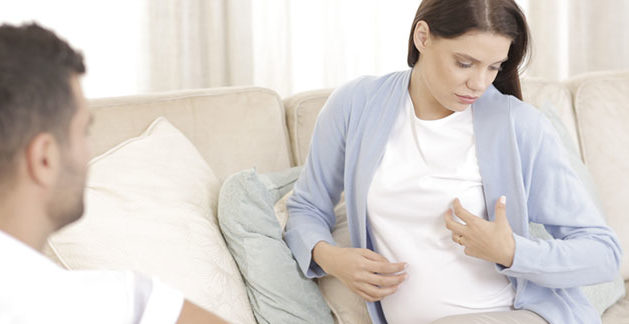Stages of Labour

Are you wondering what to expect when you go into labour? Every delivery is different but each one also follows a sequence of stages, which can be of different durations. Find out more about the stages below.
Did you know there are three stages of labour? Most of us think of childbirth as a single process, but in fact it doesn’t happen all at once. Instead, you will go through three different phases. Read on to learn about what happens at each stage, what you can expect and how to make labour more comfortable for you. If you do have any questions, the team is ready to help you.
- What are the three stages of labour?
- The first stage
- The second stage
- The third stage
What are the three stages of labour?
Labour is the physical process during which your uterus contracts and your cervix opens to allow your baby to come out into the world. Your cervix will dilate throughout these phases to approximately a full ten centimetres.
The first stage

The first stage of labour is the longest, and it can last for quite a few hours, especially if it’s your first baby, so the first thing to remember is not to panic when the signs start.
Early labour feelings
For many women, the very first sign of getting ready for labour is a cramping feeling – a bit like period pains. You may also have a bit of pain in your lower tummy or back. Some women can also have some diarrhoea or feel sick or nauseous.
During the early stages of labour you may not feel like eating very much, so it’s a good idea to have light meals like soup, cereal or toast and drink plenty of water.
The feelings of discomfort may not feel like anything unusual at first, but if you are in labour they will gradually develop into more regular and intense pains, otherwise known as contractions.
Getting your show
A plug of mucus has been sealing your cervix while you’ve been carrying your baby. When it comes away, it is known as “a show” and it means your cervix is starting to change and open. Sometimes women experience a show a few days or even a couple of weeks before labour begins and it’s a sign of things beginning to happen.
Not all women get a show in the early stages, so don’t worry if yours hasn’t appeared yet – it’s not a big deal. Your plug will come out naturally at some stage during your labour.
Breaking waters
The Amniotic fluid that surrounds your baby throughout pregnancy is commonly known as ‘waters’. When you are in labour, your waters will ‘go’ but the timing of this will vary. For some women they break early and for others it may not be until you are in active labour. Some describe the release of fluid as a trickle, others as a gush.
If your water does break in the early stages of labour, the risk of infection is increased so it’s very important to keep your vaginal area very clean. Don’t put anything into your vagina, like a tampon, and don’t have intercourse or any hot baths.
If your water breaks at home you should contact your doctor straight away, regardless of whether or not you are having contractions.
Contractions
Contractions are a tightening and relaxing of the muscles in your uterus which you may feel in the front or back and they’ll feel stronger than the irregular Braxton Hicks you may have experienced during pregnancy.
If you’re in labour you’ll start to experience contractions at increasingly shorter intervals and they’ll become longer and stronger in intensity.
A typical pattern for your early phase contractions begins by lasting about 40 seconds and they will come approximately every ten minutes. By the time you’re ready to give birth; the contractions will last about a minute and come every 2 minutes. These timings are just a guide, as they will vary from person to person.
Making the first stage more comfortable
For advice about how to have a more comfortable labour, read our tips for getting through labour, or if you want to know how to keep your energy levels up read our article food & drink during labour.
The second stage

The second stage of labour begins when your cervix has dilated to ten centimetres and it ends with the birth of your baby!
If this is your first baby, the second stage may still take an hour or even longer to complete. But if you’ve had one or more babies already, it may take as little as five minutes.
Pushing your baby out
Your body will tell you when to push – in fact the urge will probably be overwhelming and pretty difficult to resist! Once your baby’s head is visible, your doctor may encourage you to try and slow the process down by asking you to stop pushing and to pant instead. It’s a delicate stage and is important as it may help reduce the risk of tearing. You’ll gently push your baby out on the next contraction. At last your baby will be born. You’ll probably be encouraged to have skin to skin contact (if you choose to) and at this point and you can say hello to each other.
The third stage

It might seem a bit odd that you’ve still got another stage of labour to go after your baby has been born! That’s because there’s still a little bit of work left to do – delivering the placenta. Don’t worry, your doctor will stay with you and guide you through it.
Delivering the placenta
Your doctor will offer you an injection to help with the delivery of the placenta. If you choose to have the injection, delivery will probably take about 5 –15 minutes. But if you decide to deliver naturally it may take up to an hour.
You’ll find that the contractions will start again enabling you to gently push your placenta down and out of your vagina.
Once delivered, your doctor will feel your tummy to check that your uterus has started to contract now the placenta has gone. The placenta will then be checked thoroughly to make sure that it is complete.
Breastfeeding straight after birth
If you asked for skin-to-skin contact after birth, your doctor will probably encourage you to try to breastfeed straight away. This allows you to spend some special time together and will help your baby to feel immediately attached to you.




